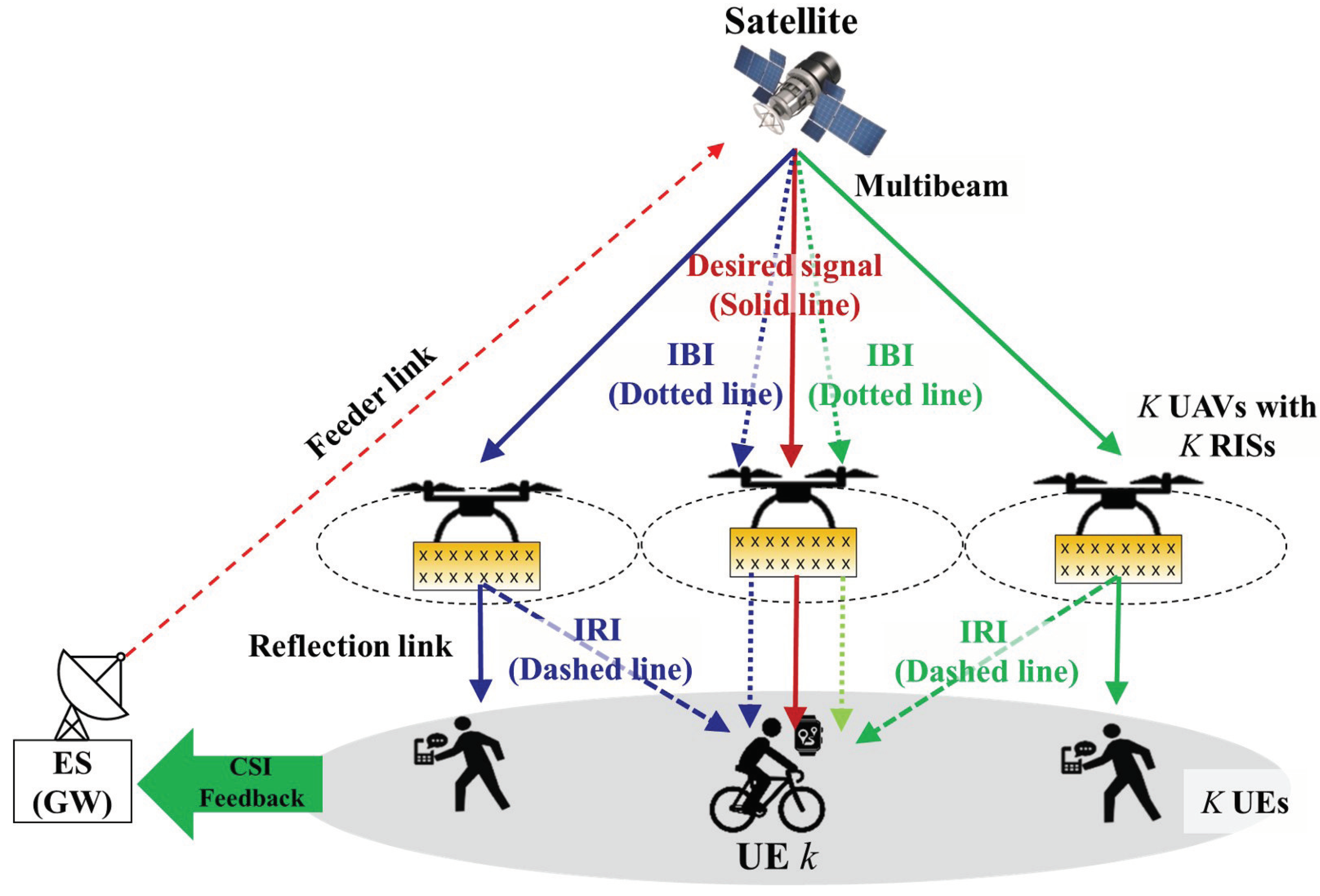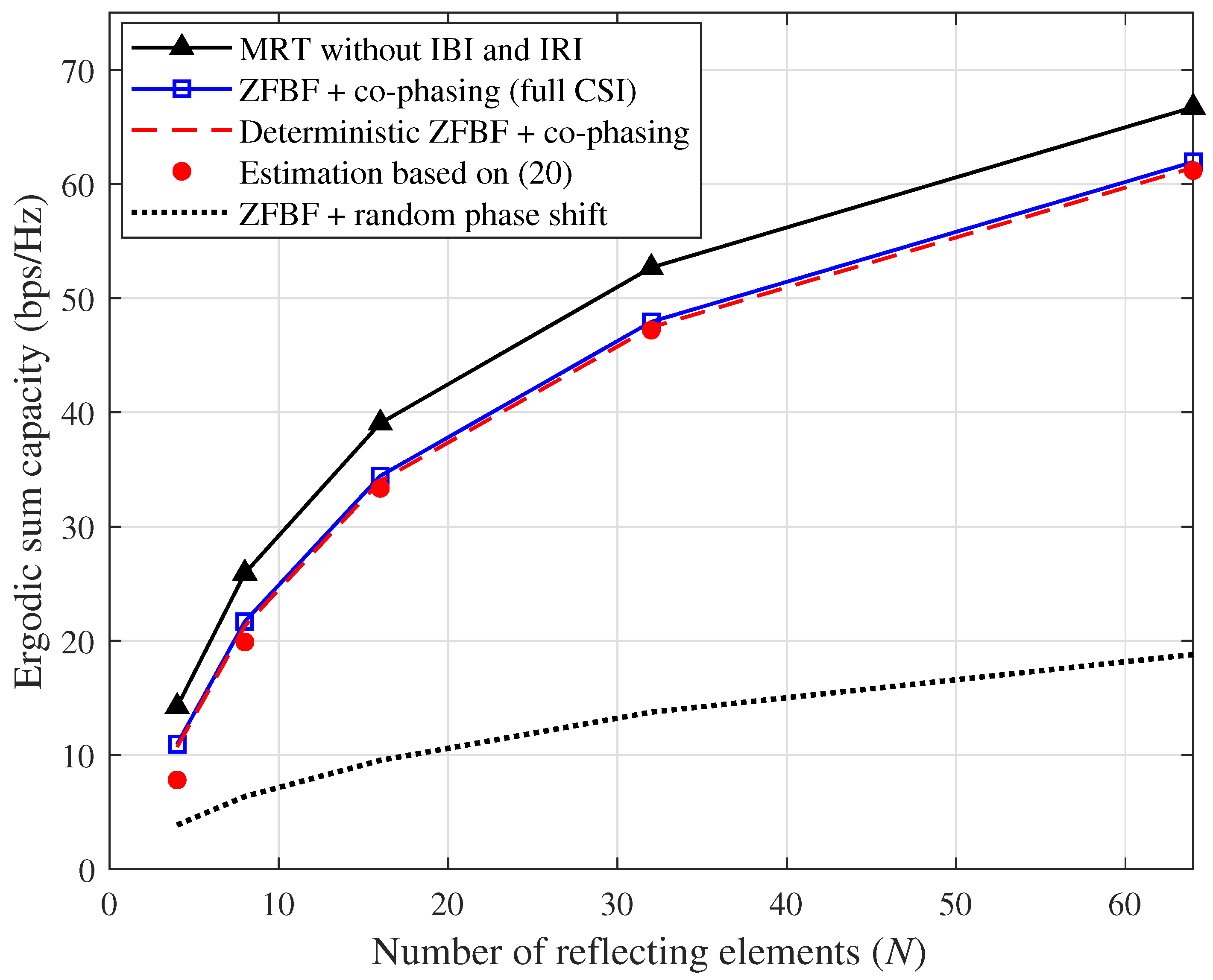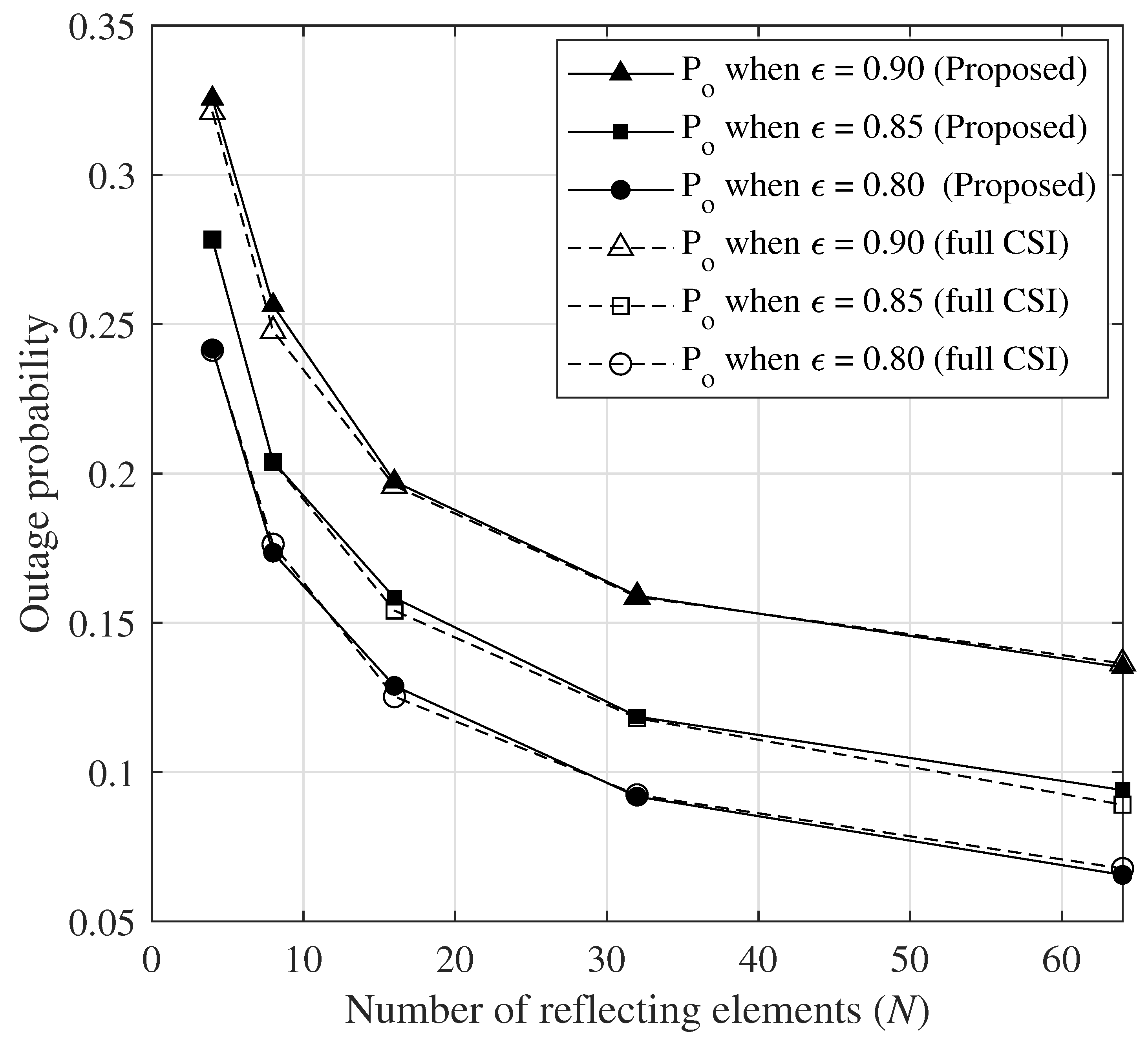Performance Analysis of RIS-Assisted SatComs Based on a ZFBF and Co-Phasing Scheme
Abstract
:1. Introduction
- First, we analyze the performance of the ZFBF combined with the co-phasing technique based on full channel state information (CSI) as the number of RIS elements increases towards infinity.
- To make the analysis more practical, we propose a novel deterministic ZFBF and co-phasing technique that only requires partial CSI while eliminating IBI and achieving near-optimal performance.
- Furthermore, we derive a closed-form expression for the asymptotic ergodic capacity of the proposed scheme.
- We then analyze the outage probability and demonstrate that the outage probability decreases as the number of RIS elements increases, thereby confirming the RIS’s ability to provide reliable SatCom services in scenarios with a large number of RIS elements.
2. System Model
2.1. RIS-Assisted SatCom Channel Model
2.2. ZFBF and Co-Phasing Technique
3. Active Beamforming and Phase Shift Design
3.1. ZFBF and Co-Phasing Technique Using Full CSI
3.2. ZFBF and Co-Phasing Technique Using Partial CSI
3.3. Asymptotic Performance Analysis
4. Simulation Results and Analysis
5. Conclusions
Author Contributions
Funding
Data Availability Statement
Conflicts of Interest
References
- Saad, W.; Bennis, M.; Chen, M. A Vision of 6G Wireless Systems: Applications, Trends, Technologies, and Open Research Problems. IEEE Netw. 2020, 34, 134–142. [Google Scholar] [CrossRef]
- Wang, S.; Zhang, L.; Fan, H. An Enhanced Multi-Constraint Optimization Algorithm for Efficient Network Topology Generation. Mathematics 2023, 11, 3456. [Google Scholar] [CrossRef]
- Xu, Y.; Deng, F.; Zhang, J. UDCO-SAGiMEC: Joint UAV Deployment and Computation Offloading for Space–Air–Ground Integrated Mobile Edge Computing. Mathematics 2023, 11, 4014. [Google Scholar] [CrossRef]
- Son, H.; Jung, M. Phase Shift Design for RIS-Assisted Satellite-Aerial-Terrestrial Integrated Network. IEEE Trans. Aerosp. Electron. Syst. 2023, 59, 9799–9806, early access. [Google Scholar] [CrossRef]
- Zhang, J.; Qi, C. Channel Estimation for mmWave Satellite Communications with Reconfigurable Intelligent Surface. In Proceedings of the 2021 IEEE Global Communications Conference (GLOBECOM), Madrid, Spain, 7–11 December 2021; pp. 1–6. [Google Scholar] [CrossRef]
- Lin, Z.; Niu, H.; An, K.; Wang, Y.; Zheng, G.; Chatzinotas, S.; Hu, Y. Refracting RIS-Aided Hybrid Satellite-Terrestrial Relay Networks: Joint Beamforming Design and Optimization. IEEE Trans. Aerosp. Electron. Syst. 2022, 58, 3717–3724. [Google Scholar] [CrossRef]
- Khan, W.U.; Lagunas, E.; Mahmood, A.; ElHalawany, B.M.; Chatzinotas, S.; Ottersten, B. When RIS Meets GEO Satellite Communications: A New Sustainable Optimization Framework in 6G. In Proceedings of the IEEE Vehicular Technology Conference, Helsinki, Finland, 19–22 June 2022; pp. 1–6. [Google Scholar] [CrossRef]
- Rahman, M.H.; Sejan, M.A.S.; Aziz, M.A.; Kim, D.S.; You, Y.H.; Song, H.K. Deep Convolutional and Recurrent Neural-Network-Based Optimal Decoding for RIS-Assisted MIMO Communication. Mathematics 2023, 11, 3397. [Google Scholar] [CrossRef]
- Rahman, M.H.; Sejan, M.A.S.; Aziz, M.A.; Kim, D.S.; You, Y.H.; Song, H.K. Spectral Efficiency Analysis for IRS-Assisted MISO Wireless Communication: A Metaverse Scenario Proposal. Mathematics 2023, 11, 3181. [Google Scholar] [CrossRef]
- Yu, Y.; Wang, J.; Zhou, X.; Wang, C.; Bai, Z.; Ye, Z. Review on Channel Estimation for Reconfigurable Intelligent Surface Assisted Wireless Communication System. Mathematics 2023, 11, 3235. [Google Scholar] [CrossRef]
- Singya, P.K.; Alouini, M.S. Performance of UAV-Assisted Multiuser Terrestrial-Satellite Communication System Over Mixed FSO/RF Channels. IEEE Trans. Aerosp. Electron. Syst. 2022, 58, 781–796. [Google Scholar] [CrossRef]
- Zhao, J.; Gao, F.; Wu, Q.; Jin, S.; Wu, Y.; Jia, W. Beam Tracking for UAV Mounted SatCom on-the-Move With Massive Antenna Array. IEEE J. Sel. Areas Commun. 2018, 36, 363–375. [Google Scholar] [CrossRef]
- Joo, C.; Choi, J. Low-delay broadband satellite communications with high-altitude unmanned aerial vehicles. J. Commun. Netw. 2018, 20, 102–108. [Google Scholar] [CrossRef]
- Perez-Neira, A.I.; Vazquez, M.A.; Shankar, M.B.; Maleki, S.; Chatzinotas, S. Signal Processing for High-Throughput Satellites: Challenges in New Interference-Limited Scenarios. IEEE Signal Process. Mag. 2019, 36, 112–131. [Google Scholar] [CrossRef]
- Hashida, H.; Kawamoto, Y.; Kato, N. Selective Reflection Control: Distributed IRS-Aided Communication With Partial Channel State Information. IEEE Trans. Veh. Technol. 2022, 71, 11949–11958. [Google Scholar] [CrossRef]
- Al-Jarrah, M.; Al-Dweik, A.; Alsusa, E.; Iraqi, Y.; Alouini, M.S. On the Performance of IRS-Assisted Multi-Layer UAV Communications With Imperfect Phase Compensation. IEEE Trans. Commun. 2021, 69, 8551–8568. [Google Scholar] [CrossRef]
- Kim, T.; Jung, M.; Son, H. Joint User Scheduling and Phase Shift Optimization for STAR-RIS-Assisted Multicast Satellite Communications. IEEE Trans. Aerosp. Electron. Syst. 2024, 1–10. [Google Scholar] [CrossRef]
- Ahmad, I.; Nguyen, K.D.; Letzepis, N.; Lechner, G.; Joroughi, V. Zero-Forcing Precoding With Partial CSI in Multibeam High Throughput Satellite Systems. IEEE Trans. Veh. Technol. 2021, 70, 1410–1420. [Google Scholar] [CrossRef]
- Tse, D.; Viswanath, P. Fundamentals of Wireless Communication; Cambridge University Press: Cambridge, UK, 2005. [Google Scholar]
- Basar, E.; Renzo, M.D.; de Rosny, J.; Debbah, M.; Alouini, M.S.; Zhang, R. Wireless Communications through Reconfigurable Intelligent Surfaces. IEEE Access 2019, 7, 116753–117773. [Google Scholar] [CrossRef]
- Yu, W.; Cioffi, J. Constant-power waterfilling: Performance bound and low-complexity implementation. IEEE Trans. Commun. 2006, 54, 23–28. [Google Scholar] [CrossRef]
- Wu, Q.; Zhang, R. Intelligent Reflecting Surface Enhanced Wireless Network via Joint Active and Passive Beamforming. IEEE Trans. Wirel. Commun. 2019, 18, 5394–5409. [Google Scholar] [CrossRef]
- Cai, X.; Song, J.; Rodríguez-Piñeiro, J.; E. Mogensen, P.; Tufvesson, F. Characterizing the Small-Scale Fading for Low Altitude UAV Channels. In Proceedings of the International Conference on Wireless and Mobile Communications, Nice, France, 18–22 July 2021; pp. 16–19. [Google Scholar]



| Parameter | Value |
|---|---|
| Orbit | LEO ( km) |
| Distance between UAV and UE | 1 km |
| Carrier frequency | 2 GHz (L-band) |
| K, , | 7, dB, |
| Rician factor | 10 dB |
| UE antenna gain | dB |
| Transmit power | 50 dBW |
| Boltzmann’s constant | J/m |
| Bandwidth per beam | 20 MHz |
| Noise temperature | 300 K |
| RIS element layout | 2D square lattice |
| RIS element spacing | m |
| Average rain attenuation | 3 dB |
Disclaimer/Publisher’s Note: The statements, opinions and data contained in all publications are solely those of the individual author(s) and contributor(s) and not of MDPI and/or the editor(s). MDPI and/or the editor(s) disclaim responsibility for any injury to people or property resulting from any ideas, methods, instructions or products referred to in the content. |
© 2024 by the authors. Licensee MDPI, Basel, Switzerland. This article is an open access article distributed under the terms and conditions of the Creative Commons Attribution (CC BY) license (https://creativecommons.org/licenses/by/4.0/).
Share and Cite
Jung, M.; Kim, T.; Son, H. Performance Analysis of RIS-Assisted SatComs Based on a ZFBF and Co-Phasing Scheme. Mathematics 2024, 12, 1257. https://doi.org/10.3390/math12081257
Jung M, Kim T, Son H. Performance Analysis of RIS-Assisted SatComs Based on a ZFBF and Co-Phasing Scheme. Mathematics. 2024; 12(8):1257. https://doi.org/10.3390/math12081257
Chicago/Turabian StyleJung, Minchae, Taehyoung Kim, and Hyukmin Son. 2024. "Performance Analysis of RIS-Assisted SatComs Based on a ZFBF and Co-Phasing Scheme" Mathematics 12, no. 8: 1257. https://doi.org/10.3390/math12081257







